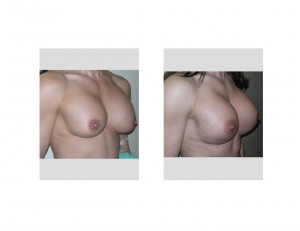Breast augmentation is an implant-driven operation that produces an immediate and dramatic change in breast contour. While there are numerous options for women to chose from in breast implants, less choice is available when it comes to where to place the implant on the chest wall. It is either above the muscle under the breast tissue (subfascial) or under the pectoralis muscle. (submuscular)
In the submuscular position there are variations in placement from total submuscular to a dual-plane location, but either way the pectoralis major muscle must be separated from the smaller underlying pectoralis minor muscle for an implant pocket. There are numerous benefits to a submuscular breast implant location but, conversely, are there are any detriments to so doing? With partial muscle avulsion there will be a longer recovery than if the muscle was not disrupted but this is a relatively short term issue.
Some women do ask if having a breast implant under the muscle will making their chest muscles weaker? While this question is not new, a theoretical answer comes from looking at the anatomy of the pectoralis major muscle and understanding the location of the ‘muscular disruption’. It is a thick, fan-shaped muscle that lies under the breast. It has two heads from which it originates, the anterior surface of the medial half of the clavicle and the anterior surface of the sternum, the superior six rib cartilages, and down onto the external oblique abdominal muscle. It inserts into the lateral lip of the bicipital groove of the humerus. (upper arm bones) The pectoralis major muscle plays a major role in many motions about the shoulder.
During submuscular placement of a breast implant, the lower attachments of the pectoralis major muscle where it attaches to the external oblique muscle are divided. This is done in order to prevent the implant from riding too high on the chest wall and allow centralization of the implant under the nipple. The insertion and the rest of the attachments of the muscle to the sternum, clavicle, and costal cartilages are left intact. Thus, weakness of the pectoralis muscle should not be expected to occur from having an implant placed underneath it.
Several studies (2003 and 2004) have looked at the maximal isometric voluntary contraction of the pectoralis major at variable times after breast augmentation and have not shown that there is any statistically change in muscle flexion, extension, or adduction compared to before surgery values. Although initially there is some decrease in function; by 6 weeks most women will have returned to their previous level of function.
The question of a potential chest muscle weakness after breast augmentation is most relevant to athletic women, particularly body builders. It would be a very similar question for pectoral implants in men. These are extreme examples of maximally ‘testing’ pectoralis major muscle both in function and in size development. As noted there are two good scientific studies that show no permanent changes in pectoral muscle strength related to breast augmentation surgery, once the initial recovery period has been completed.

Dr. Barry Eppley
Indianapolis, Indiana


